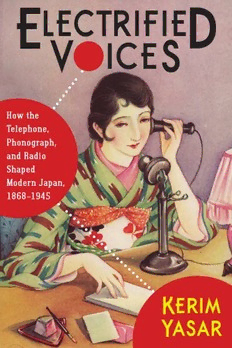
Electrified Voices: How the Telephone, Phonograph, and Radio Shaped Modern Japan, 1868–1945 PDF
Preview Electrified Voices: How the Telephone, Phonograph, and Radio Shaped Modern Japan, 1868–1945
E D LECTRIFIE V S OICE How the Telephone, Phonograph, and Radio Shaped Modern Japan, 1868–1945 KERIM YASAR ELECTRIFIED VOICES STUDIES OF THE WEATHERHEAD EAST ASIAN INSTITUTE, COLUMBIA UNIVERSITY STUDIES OF THE WEATHERHEAD EAST ASIAN INSTITUTE, COLUMBIA UNIVERSITY The Studies of the Weatherhead East Asian Institute of Columbia University were inaugurated in 1962 to bring to a wider public the results of significant new research on modern and contemporary East Asia. For a list of titles in this series, see pages 279–81 ELECTRIFIED VOICES HOW T H E T E L E P HO N E , P HO N O G R A P H , and R A D IO SHA P E D M O D E R N JA PA N , 1 8 6 8 – 19 4 5 KERIM YASAR Columbia University Press New York Columbia University Press Publishers Since 1893 New York Chichester, West Sussex cup .columbia .edu Copyright © 2018 Columbia University Press All rights reserved Library of Congress Cataloging- in- Publication Data Names: Yasar, Kerim, author. Title: Electrified voices : how the telephone, phonograph, and radio shaped modern Japan, 1868–1945 / Kerim Yasar. Description: New York : Columbia University Press, [2018] | Series: Studies of the Weatherhead East Asian Institute, Columbia University | Includes bibliographical references and index. Identifiers: LCCN 2018012328 | ISBN 9780231187121 (cloth : alk. paper) | ISBN 9780231187138 (pbk. : alk. paper) | ISBN 9780231547024 (e-book) Subjects: LCSH: Japan—Civilization—1868–1945. | Japan—History—1868– | Communication—Social aspects—Japan—History. | Sound recordings—Social aspects—Japan—History. | Mass media and culture—Japan—History. | Nationalism—Japan—History. Classification: LCC DS822.25 .Y3784 2018 | DDC 952.03—dc23 LC record available at https://lccn.loc.gov/2018012328 Columbia University Press books are printed on permanent and durable acid-f ree paper. Printed in the United States of America Cover design: Noah Arlow Cover image: Takabatake Kashoe, Natsukashi no mikoe (Nostalgia of the real voice). Japan, 1920s. Courtesy of the Yayoi Museum FOR MY MOTHER, AND FIRST AND BEST TEACHER, AZADE SEYHAN • CONTENTS List of Illustrations ix Acknowledgments xi Note on Names xvii INTRODUCTION: ALL THAT IS SOLID MELTS INTO SOUND(cid:2)1 1. VOCAL CORDS AND TELEPHONE WIRES: ORALITY IN JAPAN, OLD AND NEW(cid:2)22 2. SOUND AND SENTIMENT(cid:2)52 3. THE GRAIN IN THE GROOVE: INSCRIBED VOICES, ECHOED TEMPORALITIES(cid:2)83 4. IMAGINING THE WIRELESS COMMUNITY(cid:2)114 5. GHOSTLIER DEMARCATIONS, KEENER SOUNDS: EARLY JAPANESE RADIO DRAMA(cid:2)154 VIII(cid:2)CONTENTS 6. SOUND AND MOTION(cid:2)192 CODA- OKE(cid:2)225 Notes 229 Bibliography 253 Index 263 ILLUSTRATIONS Figure 1.1 Postcard of Fukui Post Office Telephone Exchange. 49 Figure 1.2 Telephone switchboard, Kosaka Mining, Smelting, and Refining Works. 50 Figure 4.1 Subjects of the Japanese Empire listening to the Imperial Rescript on Surrender on August 15, 1945, in Yotsuya in Tokyo, Japan. 115 Figure 4.2 Postcard of JOBK in Osaka. 117 Figure 4.3 Cover of the NHK guidebook for radio exercise leaders, 1940 (in celebration of the putative 2,600th anniversary of the foundation of Japan). 119 Figure 4.4 Interior of the NHK guidebook for radio exercise leaders. 122–23 Figure 4.5 “Sports Sketch” recording of Keiō– Waseda Baseball Game announced by Matsuuchi Norizō, 1930. 132 Figure 4.6 Recording insert of Kasai Sansei’s recording of the 800- meter relay at the 1936 Berlin Olympics. 141 Figure 4.7 Original disc of the Shōwa emperor’s declaration of surrender, NHK Museum of Broadcasting. 153 Figure 5.1 Photo of Nagata Mikihiko, featured in Musen to jikken (Radio experimenter), June 1925. 159
